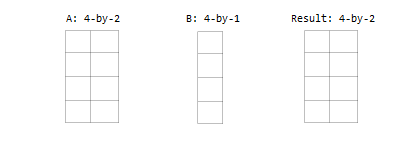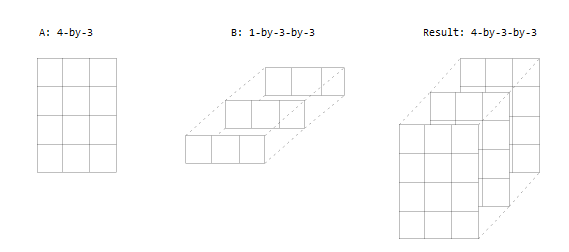基本运算的兼容数组大小
MATLAB® 中的大多数二元(两个输入)运算符和函数都支持具有兼容大小的数值数组。对于每个维度,如果两个输入的维度大小相同或其中一个为 1,则这些输入将具有兼容的大小。以最简单的情况为例,如果两个数组大小完全相同或其中一个为标量,则这两个数组大小是兼容的。执行按元素运算或函数时,MATLAB 会将大小兼容的数组隐式扩展为相同的大小。
大小兼容的输入
二维输入
以下是一些具有兼容大小的标量、向量和矩阵的组合:
两个大小完全相同的输入。

一个输入是标量。

一个输入是矩阵,另一个输入是具有相同行数的列向量。

一个输入是列向量,另一个输入是行向量。

多维数组
MATLAB 中的每个数组都具有大小为 1 的尾部维度。对于多维数组,这意味着 3×4 矩阵与大小为 3×4×1×1×1 的矩阵相同。具有兼容大小的多维数组的示例如下:
一个输入是矩阵,另一个输入是具有相同行数和列数的三维数组。

一个输入是矩阵,另一个输入是三维数组。这些维度要么都相同,要么其中一个为 1。

空数组
对于空数组或维度大小为零的数组,规则是相同的。不等于 1 的维度大小确定输出的大小。这意味着,大小为零的维度必须与另一个数组中大小为 1 或 0 的维度进行配对,并且输出的维度大小为 0。
A: 1-by-0
B: 3-by-1
Result: 3-by-0大小不兼容的输入
不兼容的输入的大小无法隐式扩展为相同的大小。例如:
其中一个维度大小不相等,并且维度大小均不为 1。
A: 3-by-2 B: 4-by-2
两个长度不相同的非标量行向量。
A: 1-by-3 B: 1-by-4
示例
从矩阵减去向量
要简化向量-矩阵运算,请对维函数(例如 sum、mean、min 以及其他)使用隐式扩展。
例如,计算矩阵中每列的均值,然后从每个元素中减去均值。
A = magic(3)
A =
8 1 6
3 5 7
4 9 2C = mean(A)
C =
5 5 5A - C
ans =
3 -4 1
-2 0 2
-1 4 -3行向量和列向量相加
行向量和列向量的大小兼容,当您对它们执行运算时,结果为一个矩阵。
例如,将行向量和列向量相加。结果与 bsxfun(@plus,a,b) 相同。
a = [1 2 3 4]
ans =
1 2 3 4b = [5; 6; 7]
ans =
5
6
7a + b
ans =
6 7 8 9
7 8 9 10
8 9 10 11